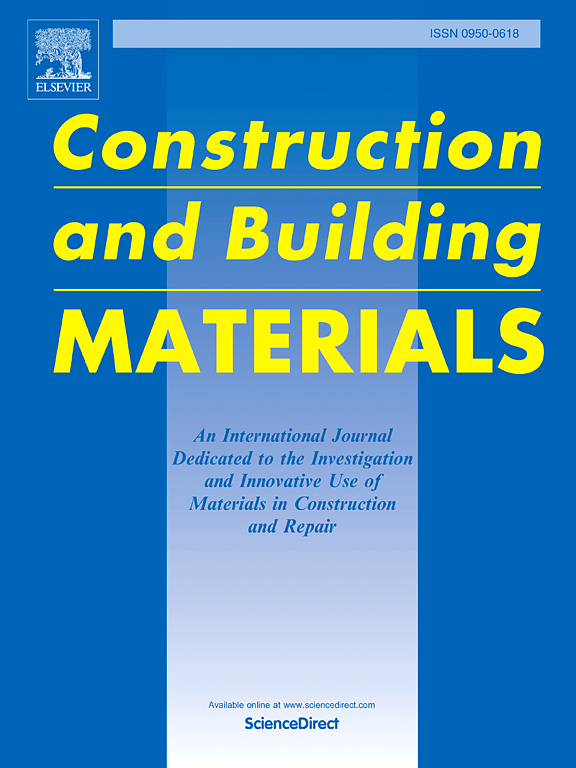From surface to core: Exploring bulk hydrophobicity in geopolymer tiles
IF 8
1区 工程技术
Q1 CONSTRUCTION & BUILDING TECHNOLOGY
引用次数: 0
Abstract
This study presents a pioneering approach to produce superhydrophobic bulk geopolymer tiles (SBGT) using a novel concurrent polymerization and cold-press technique. Unlike traditional hydrophobic coatings that degrade over time, this method achieves bulk hydrophobicity by integrating fluoroalkyl silane (FAS) modification directly into the geopolymerization process. The exothermic heat released during geopolymerization was utilized to trigger a sol-gel reaction, enabling chemical grafting of the hydrophobic agent within the geopolymer matrix. The resulting SBGT materials exhibited exceptional hydrophobic properties, with water contact angles (WCA) exceeding 150°, demonstrating complete superhydrophobicity based on both static and dynamic criteria. Self-cleaning tests confirmed the high dust-repelling capability, and liquid resistance tests demonstrated strong non-wettability against common household liquids (coffee, tea, wine, and milk). Furthermore, sandpaper abrasion and water dripping tests revealed that SBGTs maintain their hydrophobicity even under mechanical stress, highlighting their long-term durability. Additionally, mechanical strength analyses showed that while moderate FAS concentrations enhanced flexural strength, excessive amounts led to a decline due to microstructural disruptions. X-ray diffraction (XRD) and scanning electron microscopy (SEM/EDX) analyses confirmed the transformation of the geopolymer into an amorphous aluminosilicate gel, reinforcing its mechanical integrity and water resistance. This is the first study to successfully implement simultaneous concurrent polymerization and hydrophobic modification in cold press geopolymer synthesis, producing a fully hydrophobic bulk material without post-processing treatments. These findings demonstrate the commercial potential of SBGTs for self-cleaning, moisture-resistant, and energy-efficient building applications.
从表面到核心:探索地聚合物瓦片的整体疏水性
本研究提出了一种采用新型并发聚合和冷压技术生产超疏水块状地聚合物瓦(SBGT)的开创性方法。与传统的疏水涂层随着时间的推移而降解不同,该方法通过将氟烷基硅烷(FAS)改性直接集成到地聚合过程中来实现整体疏水性。利用地聚合物过程中释放的放热来触发溶胶-凝胶反应,使疏水剂在地聚合物基质中进行化学接枝。所得的SBGT材料表现出优异的疏水性,水接触角(WCA)超过150°,在静态和动态标准下都表现出完全的超疏水性。自洁测试证实了高防尘能力,耐液体测试表明对普通家用液体(咖啡、茶、酒和牛奶)具有很强的不润湿性。此外,砂纸磨损和水滴试验表明,即使在机械应力下,sbgt也能保持其疏水性,突出了其长期耐用性。此外,机械强度分析表明,虽然适度的FAS浓度提高了抗弯强度,但过量的FAS会导致微观结构破坏而下降。x射线衍射(XRD)和扫描电镜(SEM/EDX)分析证实,地聚合物转变为无定形铝硅酸盐凝胶,增强了其机械完整性和耐水性。这是第一个在冷压地聚合物合成中成功实现同时并发聚合和疏水改性的研究,生产了一种完全疏水的大块材料,无需后处理。这些发现证明了sbgt在自清洁、防潮和节能建筑应用方面的商业潜力。
本文章由计算机程序翻译,如有差异,请以英文原文为准。
求助全文
约1分钟内获得全文
求助全文
来源期刊

Construction and Building Materials
工程技术-材料科学:综合
CiteScore
13.80
自引率
21.60%
发文量
3632
审稿时长
82 days
期刊介绍:
Construction and Building Materials offers an international platform for sharing innovative and original research and development in the realm of construction and building materials, along with their practical applications in new projects and repair practices. The journal publishes a diverse array of pioneering research and application papers, detailing laboratory investigations and, to a limited extent, numerical analyses or reports on full-scale projects. Multi-part papers are discouraged.
Additionally, Construction and Building Materials features comprehensive case studies and insightful review articles that contribute to new insights in the field. Our focus is on papers related to construction materials, excluding those on structural engineering, geotechnics, and unbound highway layers. Covered materials and technologies encompass cement, concrete reinforcement, bricks and mortars, additives, corrosion technology, ceramics, timber, steel, polymers, glass fibers, recycled materials, bamboo, rammed earth, non-conventional building materials, bituminous materials, and applications in railway materials.
 求助内容:
求助内容: 应助结果提醒方式:
应助结果提醒方式:


